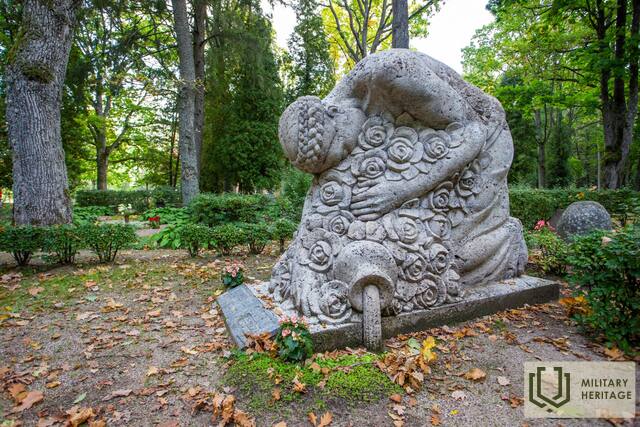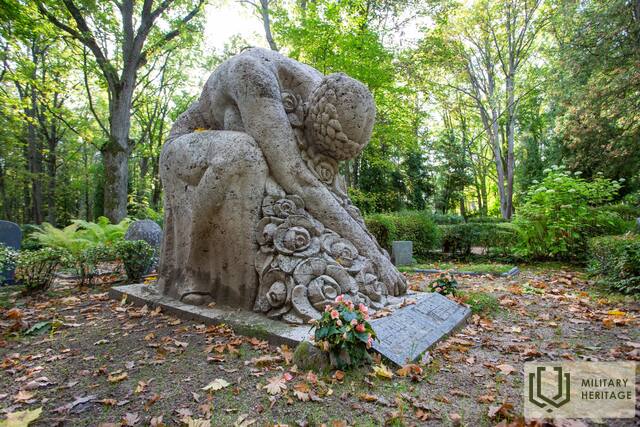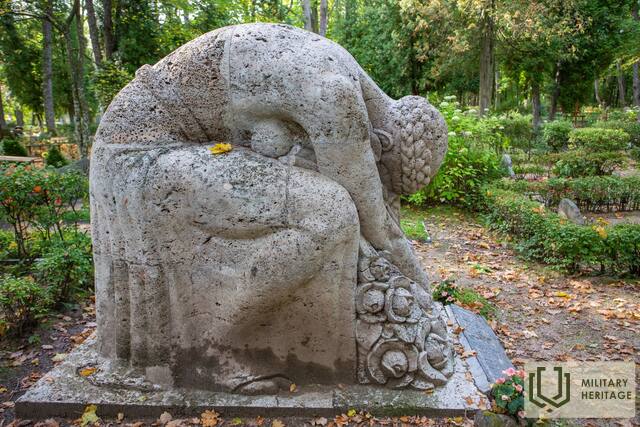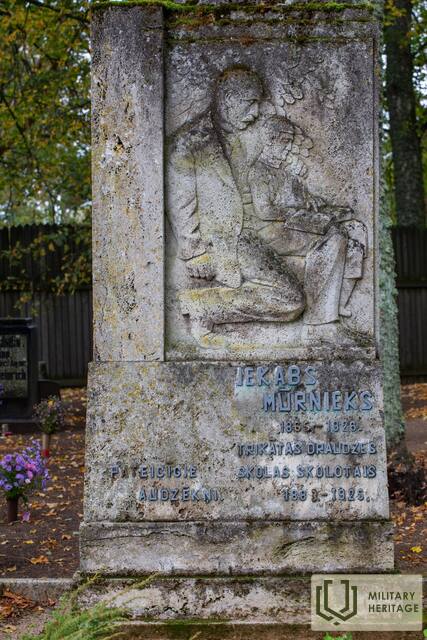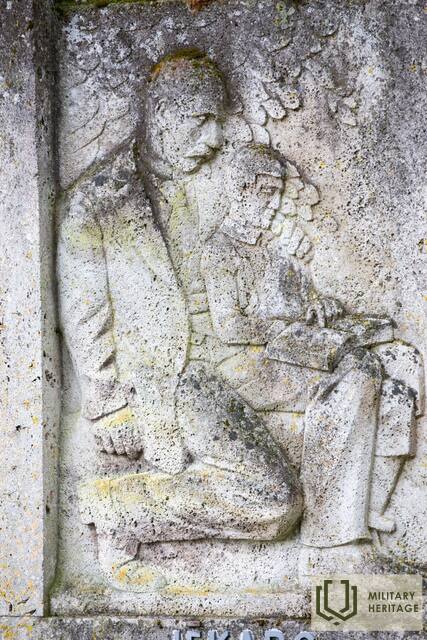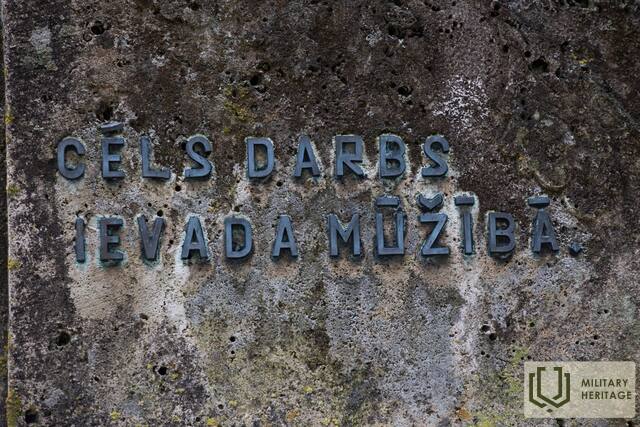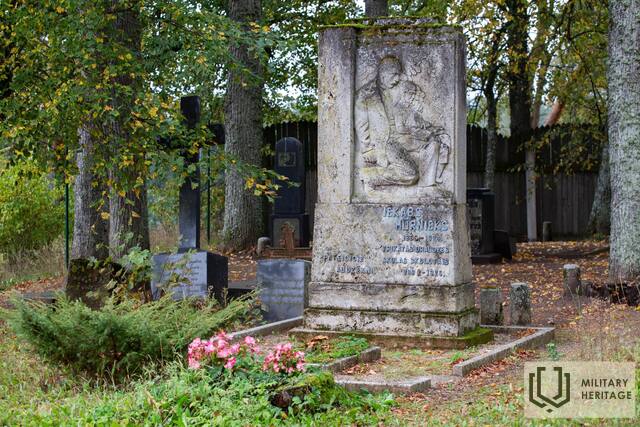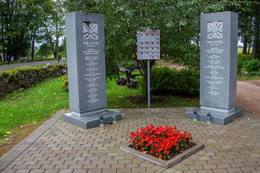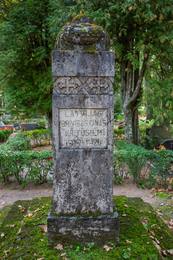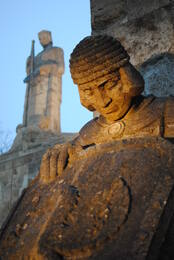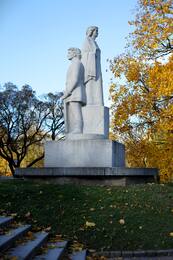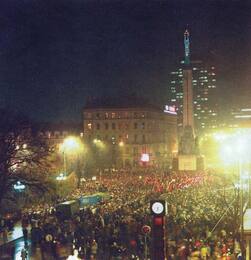About the lesser-known works of Latvian sculptor Kārlis Zāles in the old cemeteries of Dīvala and Trikāta
One of the little-known works of sculptor Kārlis Zāle (1888-1942) is the travertine sculpture "Fallen Roses", created between 1939 and 1940, and associated with the creation of the Brothers' Cemetery ensemble.
During the creation of the Brothers' Cemetery ensemble, a proposal to create a pool in the central part of the cemetery was discussed. The sculptor was preparing for such a solution and cut out these two similar sculptures, intending to place them at the entrance to the pool. However, the idea of creating a pool was rejected and a lawn was created instead. Consequently, the "Fallen Roses" did not find their place in the Brothers' Cemetery and were installed separately, near the graves of private individuals: one in the I Meža Cemetery in Riga, the other in the Dīvāli Cemetery in Valmiera. Both sculptures depict a woman who has fallen on her knees and is grieving for the departed. The fallen roses and the overturned water vessel tell the story of an interrupted life. The sculptures are made of travertine and installed on a low base.
The sculpture has been located in the Dīvalas cemetery in Valmiera since 1950.
Another lesser-known work by Kārlis Zāle is a monument to the folk teacher Jēkabs Mūrnieks (1865-1926). It is located in the old cemetery of Trikāta. “Noble work leads to eternity” — this is the teacher’s motto on the back of the monument.
The relatively complex architectural composition includes a large bas-relief, which, apparently in accordance with the wishes of the commissioners, depicts a teacher sitting under the school linden trees with an open book, with a little boy snuggling up to him. This bas-relief is almost the only one of Kārlis Zāles' works that has an illustrious illustriousness. Unusually for his handwriting, the detailing of the images is remarkable.
Jēkabs Mūrnieks worked continuously at the Trikāta parish school for 42 years, and during his time, the parish school has educated many well-known Latvian state, army, public and professional employees – the Minister of War, General Jānis Balodis, Generals Kārlis Goppers and Roberts Dambītes, a member of the Saeima, Colonel Eduards Laimiņš, Colonels Pēteris Silenieks, Mārcis Kamolas, Jēkabs Gustavs and many others.
In 1928, grateful students erected a monument to Jēkabs Mūrnieks at the Trikāta cemetery, designed by sculptor Kārlis Zāles.
http://trikatasvesture.beverina.lv/index.php/pieminekli
https://www.vestnesis.lv/ta/id/59018
http://trikatasvesture.beverina.lv/index.php/sakums/arhivs-2020
Related topics
Related objects
Memorial sites of generals and knights of the Lāčplēsis Military Order in Trikāta parish
The memorial stele is located next to the Trikāta cemetery chapel.
The Trikāta cemetery preserves the memory of three outstanding Latvian generals - Roberts Dambītis, Kārlis Goppers and Jānis Balodis. The teacher of all these generals, Jēkabs Mūrnieks, is also buried in the Trikāta cemetery, for whom a monument made of travertine, modeled after Kārlis Zāle, was erected at the burial site in 1928.
The generals and knights of the Lāčplēsis Military Order are commemorated every year with torchlight processions to the Trikāta cemetery, where there are two memorial steles, in which a total of 17 names of knights of the Lāčplēsis Military Order associated with the Trikāta parish are engraved.
The stele was unveiled on November 11, 2018.
Video about the Lāčplēsis War Order and a set of orders that belonged to General Jānis Balodis.
Military heritage monuments at the Dīvaliņas cemetery in Valmiera
Located in the Valmiera Dīvalas (Jānis) Cemetery in Valmiera.
A monument made of Allaži travertine, designed by sculptor Marta Lange and unveiled on September 26, 1937, is visible.
The pillar-shaped monument is topped by a sloping altar, on which stands a wreath of oak leaves and a helmet carved from travertine.
Approximately 80 soldiers who fell in the Latvian War of Independence, as well as those who died from injuries and diseases, are buried.
Nearby is one of the lesser-known works of Kārlis Zāles - the monument "Fallen Roses", which is associated with the creation of the Brothers' Cemetery ensemble.
Nearby is also a memorial to the victims of communist terror - a stone with the inscription: "To those murdered by the communist regime in 1941" and white crosses.
Brothers' Cemetery in Riga
Riga Brothers’ Cemetery is located in the northern district of Riga. The cemetery extends over an area of 9 ha and is the most outstanding and significant memorial ensemble in Latvia dedicated to the fallen Latvian soldiers. About 3,000 soldiers are buried here. The Brothers’ Cemetery was created during World War I after the first three Latvian Riflemen, who fell in Tīreļpurvs in the battle against the German Army, were buried here. Later Latvian soldiers who had died in other battles and wars would also be buried in the Brothers’ Cemetery. The memorial is based on the design of the sculptor Kārlis Zāle, and is the first memorial ensemble in Europe with such landscape, architecture and sculptural value. It uses elements typical to the Latvian landscape, traditional farmsteads, Latvian folklore and history that praise the characteristics of soldiers and tell the story of the way of the soldier. The memorial was unveiled in 1936 and it has three parts: ‘The Road of Though’ which is a 250 m long alley, ‘Terrace of Heroes’ with the Altar of the Sacred Flame and ensemble the Sacred Oak Grove, and the burial ground with the Latvian wall and a memorial of a mother with her fallen sons.
Dobele Liberation Monument
The Dobele Liberation Monument is located in Dobele, approximately 250 meters west of the Bērze Bridge, opposite the Dobele Castle ruins.
The Dobele Liberation Monument is dedicated to the soldiers who fell in World War I and the Latvian freedom struggle. Sculptor Kārlis Zemdega created the Dobele Liberation Monument as a two-figure composition, where the ancient Latvian soldier is a symbol of the strength of the people, and the folk girl - the image of the Motherland - expresses the ideal of spiritual clarity.
The idea to build a monument in Dobele was put forward in 1924, but work on the monument was started by K. Zemdega only ten years later, in 1934. The monument was carved from a 44-ton block of Finnish granite, and together with the base the monument reached a height of 4.5 m. The ceremonial opening of the monument took place on June 9, 1940, at the site of the current Soviet soldiers' cemetery monument, on Brīvības Street, where the Dobele Liberation Monument stood until 1950, when it was blown up by order of the Soviet authorities.
With the beginning of the era of national awakening and thanks to the persistent activities of the initiators of the restoration of the monument created by K. Zemdega - the Dobele branch of the Latvian Culture Foundation, on July 21, 1988, the Dobele District Committee Office of the Communist Party of Latvia and the Executive Committee of the Dobele District Council of People's Deputies made a decision to support the initiative of the Dobele work collective and residents to restore the monument destroyed during the Stalin cult. At the same time, the Monument Restoration Fund was established, into which donations from companies, organizations and private individuals were used to restore and install the K. Zemdega monument in the square opposite the ruins of Dobele Castle. This place was selected taking into account the results of a survey of residents. The monument was restored and installed in 1996 thanks to the donations of Dobele residents. The monument was made of granite stone brought from Zaporozhye, Ukraine, and was sculpted by stonemason Liberijs Peļņa after a design by sculptor Inta Berga.
Freedom Monument in Riga
The Freedom Monument was one of the central symbolic points of the Awakening events. On June 14, 1987, the human rights group Helsinki-86 organized an unauthorized public flower-laying ceremony at the Freedom Monument. Two months later, on August 23, Helsinki-86 called for a rally at the Freedom Monument on the 48th anniversary of the Hitler-Stalin Pact of August 23, 1939. During this rally, Soviet police beat and arrested demonstrators. In the following years, flower-laying ceremonies at the Freedom Monument became a part of all major demonstrations and other mass events .
Located in the center of Riga, on Freedom Square.
The Freedom Monument is one of the most outstanding monuments of Latvian history, architecture and art. Built according to the project of Kārlis Zāle with public donations. It was unveiled in 1935 as a symbol of the Latvian people's freedom and love of their homeland. Together with the Riga Brothers' Cemetery ensemble, it belongs to the most valuable examples of monumental architecture and sculpture.
The Freedom Monument expresses the ethical and aesthetic values of Latvian culture. The symbols reflect the philosophical essence of freedom and the historical ideas of the Latvian nation about the stages of the struggle for independence. They point to the embodiment of physical and spiritual strength. The heroic language tells the story of the Latvian people as self-reliant, active creators of history and the determinants of their own destiny.
In its place, there was originally a monument to Russian Tsar Peter I. During World War I, it was dismantled to be transported by ship to Petrograd. The ship was torpedoed by a German submarine, and it sank off the Estonian island of Vormsi. The Soviet occupation regime planned to demolish the Freedom Monument several times, but this did not happen.
Today, you can see one of the symbols of Latvia and observe the traditions of the army honor guard.
A tactile Freedom Monument has been created on the canal bank, next to the Freedom Monument. This special bronze miniature was created by sculptor Ivars Miķelsons on a scale of 1:50.





